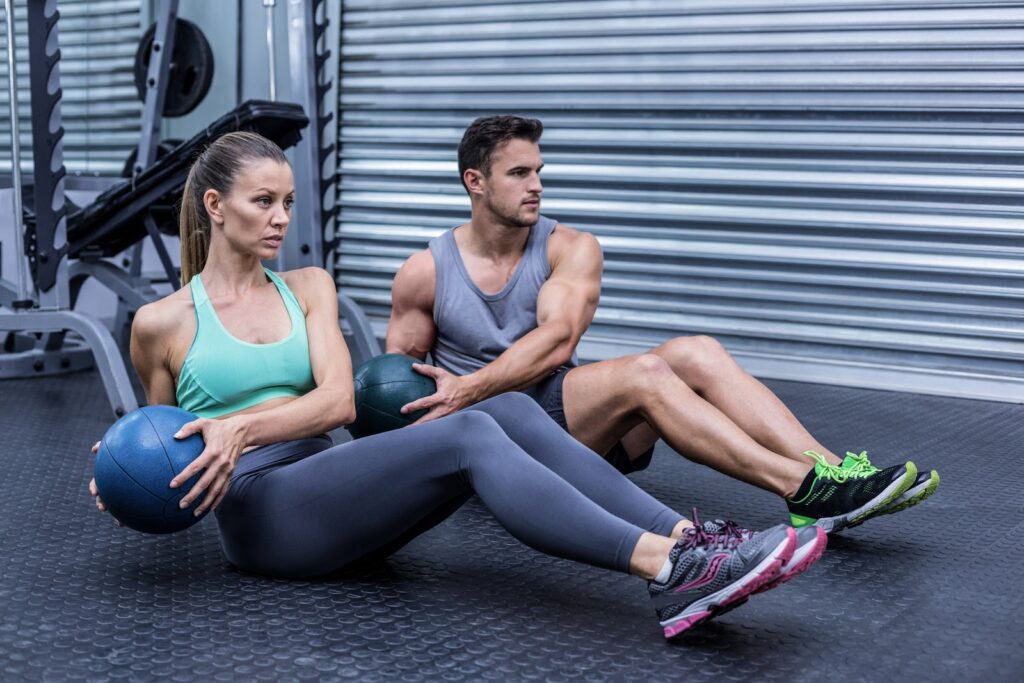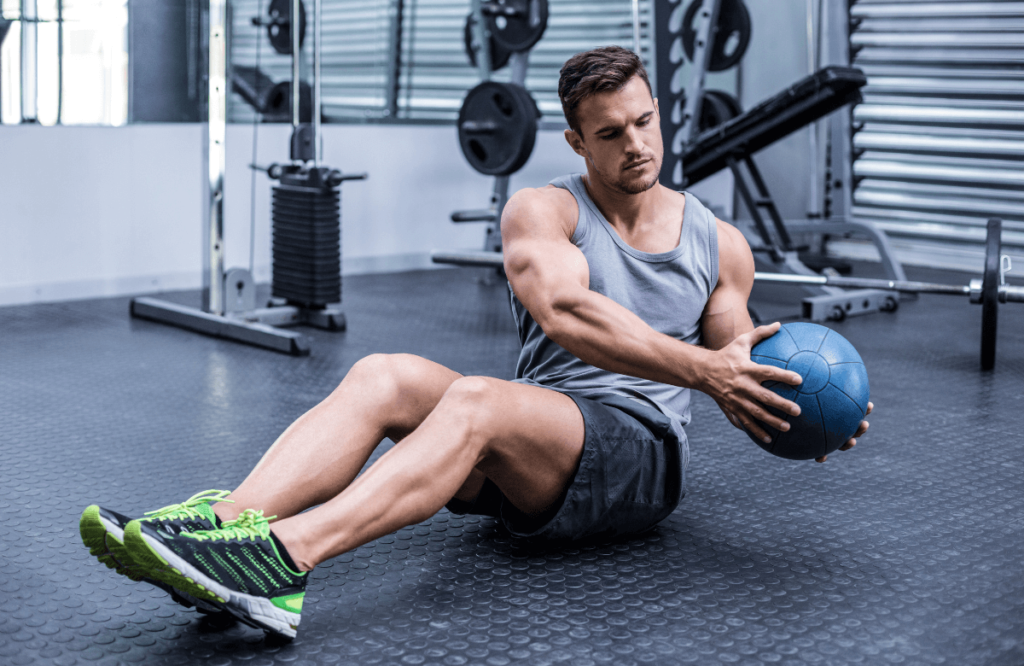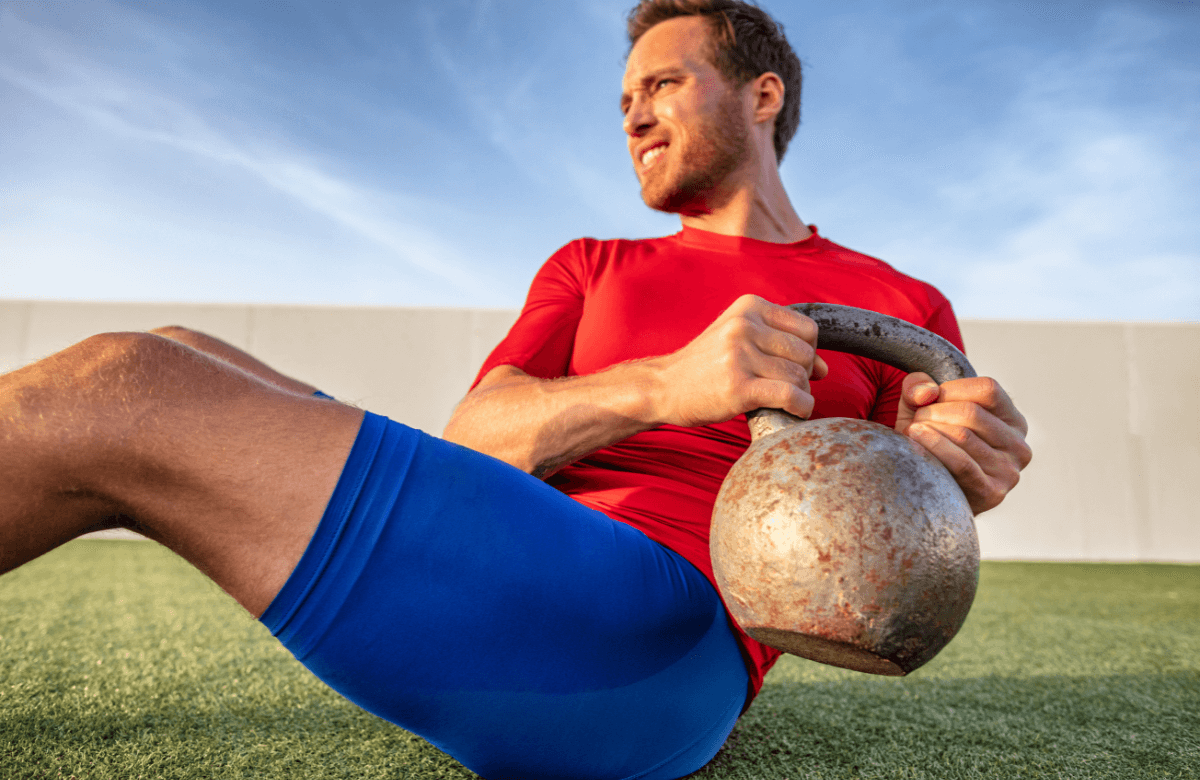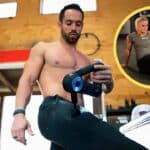Abs! We all want them, but most of us groan at the thought of doing ab exercises. Thankfully, if you choose the right ab exercises and do them consistently, you can see results—provided your diet is on point, of course!
One of the exercises we particularly love for building a great set of abs are Russian Twists kettlebell style ! It takes a bit of focus and constant mindfulness to do it right, but once you know how, it’s an excellent movement to add to your exercise routine.
Here’s everything you need to know about russian twists kettlebell, including why you should be doing it and how to do it right for best results!
Jump to:
- What are Russian Twists Kettlebell?
- What Muscles are Used in the Kettlebell Russian Twist?
- What are the Benefits of the Kettlebell Russian Twist?
- How to Do Kettlebell Russian Twist Safely
- Russian Twist Variations
- Mistakes to Avoid
- Who Shouldn’t Do a Kettlebell Russian Twist?
- Will Russian Twists Make Your Waist Bigger or Smaller?
- Will Russian Twists Define Your Abs?
- Russian Twists With Kettlebells vs Sit Ups
- Russian Twists With Kettlebells Workout Examples
What are Russian Twists Kettlebell?
A Russian Twist is an excellent core muscle activity exercise. You can do them with or without weight—either way, they really work your core! A kettlebell Russian Twist is simply the exercise done using a kettlebell for weight.
It’s a seated exercise. You’ll sit on the floor (or a mat, which is much more comfortable!), lift your feet off the floor, keeping your back straight, and move your hands—or the kettlebell—from one side of your body to the other, while keeping your feet up.
Without weight, it can be an explosive and fast exercise. With weight, it’s a slower, more controlled movement that has great muscle-building properties.

What Muscles are Used in the Kettlebell Russian Twist?
The Russian Twist, with or without weight, targets three main muscles:
- The core
- The oblique muscles
- Glutes!
However, it does work some secondary muscles as well, including:
- Hip flexors
- Shoulders
- Spinal stabilizer muscles
- Lower back muscles
What are the Benefits of the Kettlebell Russian Twist?
The kettlebell Russian Twist provides two amazing benefits, aside from strengthening and growing the abdominal muscles.
Reinforces Stabilizing Muscles
Your core is extremely important when it comes to stabilizing the body. Without a strong core, you’re much more at risk of injuring yourself doing normal things, like bending, twisting, or even stretching!
The Russian Twist helps to strengthen and reinforce those stabilizing muscles. The core acts like a supporting structure, helping the body to stand tall and brace against external force.
Doing an exercise like the Russian Twist can make a big difference to your level of core strength. Doing it with weight, like a kettlebell Russian Twist, is even better for strengthening those stabilizers!
Improves Flexibility
The Russian Twist can also improve your flexibility, as long as you do it right. It’s important to do it mindfully, so you can feel the muscles being worked.
The motion of “twisting” from side to side, when controlled, can help to make you more flexible. Your hip flexors get a good stretch and workout with the RT, which means you’re much less at risk of suffering from tight, inflexible hips.
And of course, your flexibility for things like bending, leaning, and twisting during natural movement increases.

How to Do Kettlebell Russian Twist Safely
The movement really doesn’t seem too complicated, but getting it right is extremely important.
Get it right, and you’ll start to see the benefits above, as well as getting nicely defined abs (as long as your diet is on point!).
But do it wrong, and you might inadvertently injure yourself. Not only that, but you’ll be doing the exact opposite of what you should be doing—placing the important muscles at risk, rather than strengthening them.
Here’s how to do Russian Twists safely and effectively with a kettlebell.
- Assume the starting position by sitting on the floor (mat recommended), with your knees bent and your feet on the floor in front of you. The kettlebell should be next to you.
- Lift your kettlebell slowly and carefully and hold the kettlebell at chest level.
- Lean back about 45 degrees and raise your feet off the floor.
- At this point, you should tense your core and your glutes to stabilize yourself.
- Your back should be straight, at a right angle to your thighs.
- Tighten your abs and rotate your torso, dipping the kettlebell to touch the floor on one side of you.
- Turn back to the center, and then do the same on the other side.
- Perform the movement in a controlled, mindful way.
- Make sure your hips and knees don’t rotate during the movement.
- Do as many reps as you can safely, without losing form.
You can cross your feet to keep them more stable if you prefer. The ultimate goal is to be able to do the Russian Twist with your feet straight out in front of you, but that takes quite a bit of practice to get right!
Keep your core and glutes tight throughout the movement. Start with your knees bent, as much as you need to stay stable. Check out the variations below for some easier versions!
Tip: Pick a point ahead of you to focus on throughout the movement. You shouldn’t be rotating your neck with the torso, and this is an easy way to help keep your form correct.
Russian Twist Variations
Without Weight
If you’re completely new to Russian Twists, it may be best to do it without weight until you’re used to the movement.
Don’t think that it’s too easy this way—without weight, you can turn it into a more explosive movement that really does work those muscles. A weighted twist needs to be a slower, more controlled movement.
The entire movement is the same as it is with the kettlebell, except that you place your fingertips together and work on touching the floor with your fingertips.
Take care to keep your form the same throughout—you’ll still need to tighten your core and glutes even though there’s no weight.
Feet Down
If you can’t keep your form while your feet are off the ground, you can place them down. This will help to stabilize you, but it does take some work away from the core.
It’s a good way to start building up strength. Your muscles won’t have to work as hard, but they’ll still get enough of a workout to build strength.
You can graduate to feet off the ground whenever you feel like you can maintain your form throughout the movement for at least 8 reps.
Feet Supported
Alternatively, you can support your feet off the ground with something like a stack of books, a bosu ball, etc. Whatever you have!
This will engage the core more, but still help you to stabilize yourself a little and maintain proper form throughout the exercise.
Arms Straight
This is a more advanced variation of the RT, so we advise only trying it once you’re familiar with and can do a decent amount of reps of the regular version.
Instead of holding the kettlebell close to your chest, extend your arms so they’re straight. In this case, you won’t aim to touch the kettlebell to the floor—simply move it side to side, keeping it at the same height.
Your form should stay the same—core tight, glutes tight, focused on a single point ahead of you, feet up or supported. It’s also a good idea to only try this one if you have some good arm strength already!

Mistakes to Avoid
Using Too Much Weight
Using a kettlebell that’s too heavy is going to ruin your form, reduce the effectiveness of the exercise, and make you more prone to injuring yourself. It’s only going to put strain on your arms, neck, and back, which will take over if the weight is too heavy for your core to handle.
It might be tricky to find the right kettlebell for your needs initially. Err on the side of caution—if the weight is a little too light, you can always do more reps or use a harder variation. You should be using a weight that allows you to do at least 8 to 10 reps with impeccable form.
Not Breathing Properly
It’s easy to hold your breath while you’re doing the Russian Twist, because of the rotation of the torso. But not breathing through the exercise will deplete your body of energy faster, so you won’t be reaching your maximum potential.
If you find that you aren’t breathing properly, slow down your reps. This will allow for optimal muscle engagement, and also give you room to breathe deeply and effectively.
Arching Your Back
Keeping your back straight is key to proper form. Arching your back can lead to injury easily, as it takes the engagement away from the core and places it on the spine, which can be dangerous.
Make sure your back stays as straight as possible at a 45-degree angle (or close to that), and keep your core tight. This helps to stabilize the back muscles and stop it from arching.
Moving the Legs
Your legs will move a little as you rotate from side to side. But if you’re swinging your legs in an attempt to facilitate the rotation, you’re reducing the effectiveness of the motion.
Keep your legs as still as possible throughout the movement. If you can’t stop them from swinging, try supporting them with something rather than holding them in the air.
Who Shouldn’t Do a Kettlebell Russian Twist?
If done with proper form, the kettlebell Russian Twist should be safe. However, if you have existing lower back injuries or suffer from lumbar disc pain, it may be best to work on other rehabilitation exercises before attempting to do Russian Twists, even without the kettlebell.

Will Russian Twists Make Your Waist Bigger or Smaller?
One of the biggest misconceptions about ab exercises is that they trim the fat off your waist and leave you looking slimmer. Not so! Firstly, you can’t spot-reduce fat, so your diet and compound exercises will contribute far more to stripping of fat.
Secondly, if you do your ab exercises right, your muscles will get bigger. Which means that if you’re doing your Russian Twists correctly, your obliques will increase in size and can make your waist look wider!
However, this is only likely to be the case after a lot of perfect-form training with heavier weights. If you’re just training them once or twice a week without weight or with manageable weight and perfect form, you’re highly unlikely to start looking like a tank.
Will Russian Twists Define Your Abs?
The Russian Twist is actually a comprehensive core exercise, which targets the obliques mostly but also has an effect on the rest of the core. This one exercise will strengthen your whole core, so if you’re doing it regularly, you have a good chance of developing more definition in your core.
However, it’s important to note that no amount of ab exercises are going to make your abs visible! Lowering your body fat to the point where your abs can be seen is almost all down to diet.
Russian Twists With Kettlebells vs Sit Ups
Both Russian Twists and sit-ups have their place in a workout routine. Also, both need to be done with excellent form in order to stay safe and get the most out of the exercise.
However, Russian Twists do have some advantages over sit-ups. The RT works the entire core—while you’re likely to feel it more in the obliques, it’s also giving the transverse abdominis and rectus abdominis a good workout.
The sit-up works fewer core muscles, and it also has just as much—if not more—chance of leading to injury. Especially for those with a weak core, you’re likely to strain your neck on the lifting or lowering movements, which is dangerous and can be extremely painful.
Ultimately, it’s up to you which one you choose, or if you incorporate both of them into your workout routine.
Russian Twists With Kettlebells Workout Examples
Want some ideas on how to incorporate Russian Twists into your ab workout? It’s simple… Just add them to whatever else you’re doing, but be sure to cover all aspects of the core.
Ab Workout 1
- Captain’s Chair Leg Raises
- Russian Twists with Kettlebell
- Plank
Ab Workout 2
- Ab Rollouts
- Russian Twist
- Chair Sit-Ups















